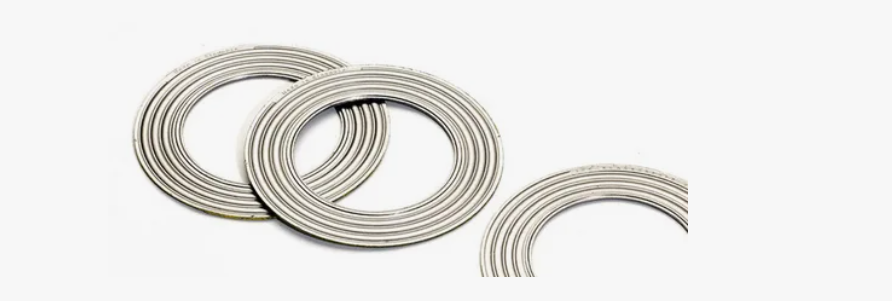RILSON GASKET
Ningbo Rilson Sealing Material Co., Ltd is dedicated to ensuring the secure and dependable operation of fluid sealing systems, offering clients the appropriate sealing technology solutions.
Corrugated metal gaskets, as a high-performance sealing material, are widely used in industries such as petrochemicals, energy, power, and machinery manufacturing. In high-temperature, high-pressure, highly corrosive, or cyclically changing pressure conditions, corrugated metal gaskets, with their excellent elastic recovery and compression resistance, have become an ideal choice for sealing flanges in many equipment. However, no matter how good the gasket's performance is, improper installation can cause leaks, crushing, or even safety accidents. Therefore, correct installation is crucial.
The following details the correct use of corrugated metal gaskets from three aspects: pre-installation preparation, assembly points, and common mistakes.
1. Pre-installation Preparation
Before installing corrugated metal gaskets, a series of checks and confirmations are required to ensure that the gasket is in a suitable operating environment.
(1) Check if the flange surface is flat and clean
The flange sealing surface must be free of scratches, burrs, rust, or residual gasket fragments.
Clean with a wire brush or solvent.
The surface roughness should meet the gasket requirements; otherwise, it will affect the sealing performance.
Especially for metal gaskets, the quality requirements for the sealing surface are even higher; any defects may lead to leakage.
(2) Confirm gasket specifications and model
Before installation, check:
Whether the gasket material is suitable for the working conditions (e.g., stainless steel, graphite coating, etc.)
Whether the dimensions match the flange
Whether the thickness is appropriate
Whether the temperature and pressure ratings meet the requirements
Avoid using "close enough" gaskets to avoid affecting the sealing effect.
(3) Check if the corrugated structure is intact
The corrugations are the core structure for the gasket's elastic recovery and sealing performance. Before installation, it must be confirmed that:
The corrugations are not broken
There is no obvious deformation
The graphite, PTFE, and other coating layers are firmly in place and have not fallen off.
If damage is found, it should be replaced immediately.

2. Key Points for Installing Corrugated Metal Gaskets
Correct installation procedures can effectively improve sealing performance and service life.
(1) Correct Centering
The gasket must be precisely centered on the flange and cannot be offset. Eccentricity will lead to uneven stress, causing:
Overpressure in some areas leading to gasket damage
Insufficient pressure in some areas leading to leakage
If the flange is large, it is recommended to use a temporary positioning tool to assist in installation.
(2) Even and Symmetrical Tightening of Bolts
Tightening is a crucial step in installing corrugated metal gaskets and must follow the principle of "symmetry + segmentation":
The tightening steps are usually as follows:
First, pre-tighten with 30% torque
Second, tighten evenly with 60% torque
Third, reach 100% torque
Finally, recheck diagonally
This method ensures consistent stress on the gasket, avoiding excessive compression on one side or insufficient sealing on the other.
(3) Control the appropriate tightening force
Corrugated metal gaskets have specific requirements for tightening force:
Too low: Inadequate sealing, causing leakage
Too high: Corrugations are damaged, losing their elasticity and recovery ability
It is recommended to tighten according to the gasket model, flange grade, and bolt specifications, referring to the torque table provided by the manufacturer.
(4) Avoid applying lubricant directly to the gasket surface
Some installers are accustomed to applying oil or grease to the gasket surface, which will affect the friction between the gasket and the sealing surface, leading to:
Gasket slippage
Unstable sealing
Stress concentration
Lubricant should only be applied in small amounts to the bolts and should never be applied to the gasket.
3. Key points to check after installation
After installation, a comprehensive inspection is required:
(1) Confirm whether the bolt torque meets the standard
Use a torque wrench for re-inspection to avoid errors caused by manual judgment.
(2) Check for changes in flange gap
The gap on both sides of the flange should be consistent; otherwise, it indicates:
The gasket is not centered
Uneven bolt force
Readjustment is required.
(3) Trial Run Observation for Leakage
Pay close attention during system pressurization or heating:
Any slight leakage
Any abnormal sounds or vibrations
Any localized overheating
If necessary, perform secondary heat tightening to improve sealing performance.
4. Avoid These Common Mistakes
When installing corrugated metal gaskets, the following mistakes are most likely to cause leakage or damage:
Using old gaskets directly
Gasket surface contaminated with oil, water, or impurities
Continuing to use severely deformed flanges
Not tightening bolts according to torque standards
Using gaskets beyond their operating conditions (excessive temperature or pressure)
Avoiding these problems ensures truly reliable sealing.
Corrugated metal gaskets possess excellent sealing and adaptability, but only if installed correctly. Only by conducting thorough inspections before installation, ensuring even stress distribution during installation, and performing post-installation checks can the gasket achieve its intended lifespan and sealing performance. For industrial equipment, a small gasket is crucial to the safe operation of the entire system; therefore, installation must not be taken lightly.